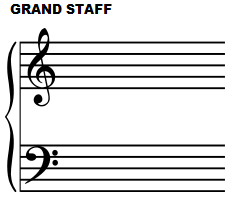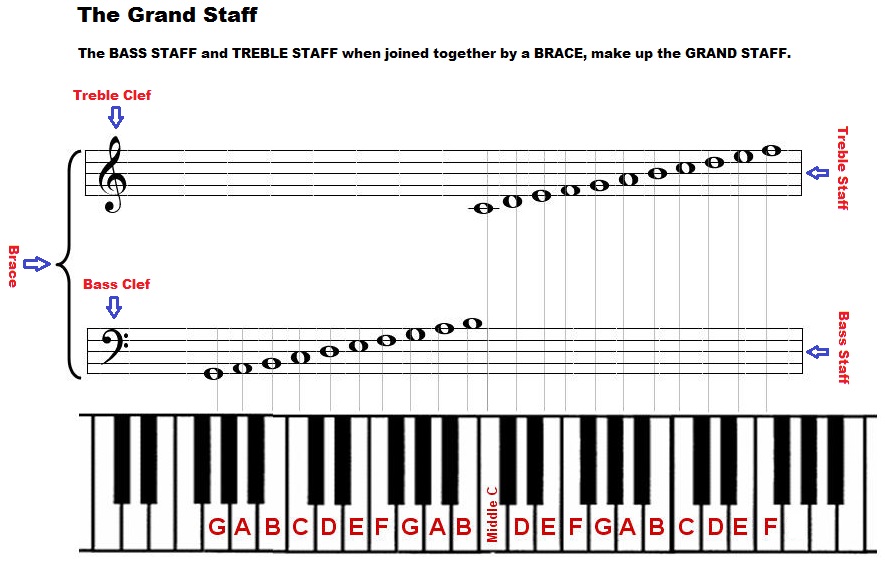In this basic music theory lesson, we take a look at the grand staff (or great stave in British English). It is really two staves joined together by a brace. (Staves is the plural of staff or stave).
Highly Recommended: Click here for one of the BEST piano/keyboard courses I’ve seen online.

A staff or stave is a set of five horizontal lines and four spaces that each represent a different musical pitch. The upper staff makes use of what is known as a treble clef, while the lower staff uses a bass clef.
Middle C is centered between the two staves. Middle C can be written on the first ledger line above the lower staff, or first ledger (or leger) line below the upper staff.
As a piano player or student, when you come across a grand staff, you should play the notes on the upper staff (treble staff) with your right hand and those on the lower staff (bass staff) with your left hand.
As for middle C, if it is written with a ledger line below the the treble staff, you play it with your right hand. If it is written with a ledger line above the bass staff, play the note with your left hand.
Watch This Lesson:
The Grand Staff – Treble and Bass Staff Notes
Let’s take a closer look at these two staves we have mentioned above.
Treble Staff Notes
Firstly, we shall take a look at the lines in the top staff or treble staff. The notes of the lines on the treble staff are as follows:
Line Notes: Starting on the lowest of the five lines, the notes that correspond to the lines of the treble staff are E G B D F. A good way to remember this is with the phrase “Every Good Boy Does Fine”.
How about the spaces?
Space Notes: Starting on the first space, the notes that correspond to the spaces of the treble staff are F A C E. It’s a spelling of the word, “face” and is easy to remember.
Bass Staff Notes
We now take a look at bass staff notes.
These notes are often lower than middle C on your piano, but it’s common to see them above middle C.
Line Notes: Starting on the lowest of the five lines, the notes that correspond to the lines of the bass staff are G B D F A. A great way to remember this is with the phrase “Good Boys Do Fine Always”.
How about the spaces of the bass staff?
Space Notes: Starting in the first space, the notes that correspond to the spaces of the bass staff are A C E G. To help you remember, a good phrase is “All Cows Eat Grass”.
Let’s talk about the treble clef and bass clef for a moment.
The treble clef is also known as the G clef because it first of all looks like a stylized G, and most importantly, because it circles around the second staff line which (not coincidentally) represents the note, G. This is the G that is closest to the middle of your piano keyboard. Find this G on your piano and the other lines and spaces on your staff are easy to find.
The bass clef is also called the F clef. Look closely at this clef and you will notice that there are two dots surrounding the staff line, representing the F note. To read the notes on the bass clef, simply start with the F line and travel backward and through the musical alphabet, A B C D E F G.
Ledger Lines
The piano has as many as 88 notes and it would appear that we would at some point run out of room to place notes on the grand staff. What happens now? The solution to our dilemma is the leger line. A leger line is a short horizontal line placed above or below the musical staff to accommodate notes higher or lower than the range of the staff.
Learn to read piano notes, plus further reading on the grand staff.
Piano Notes and Keys – 88 Key Piano